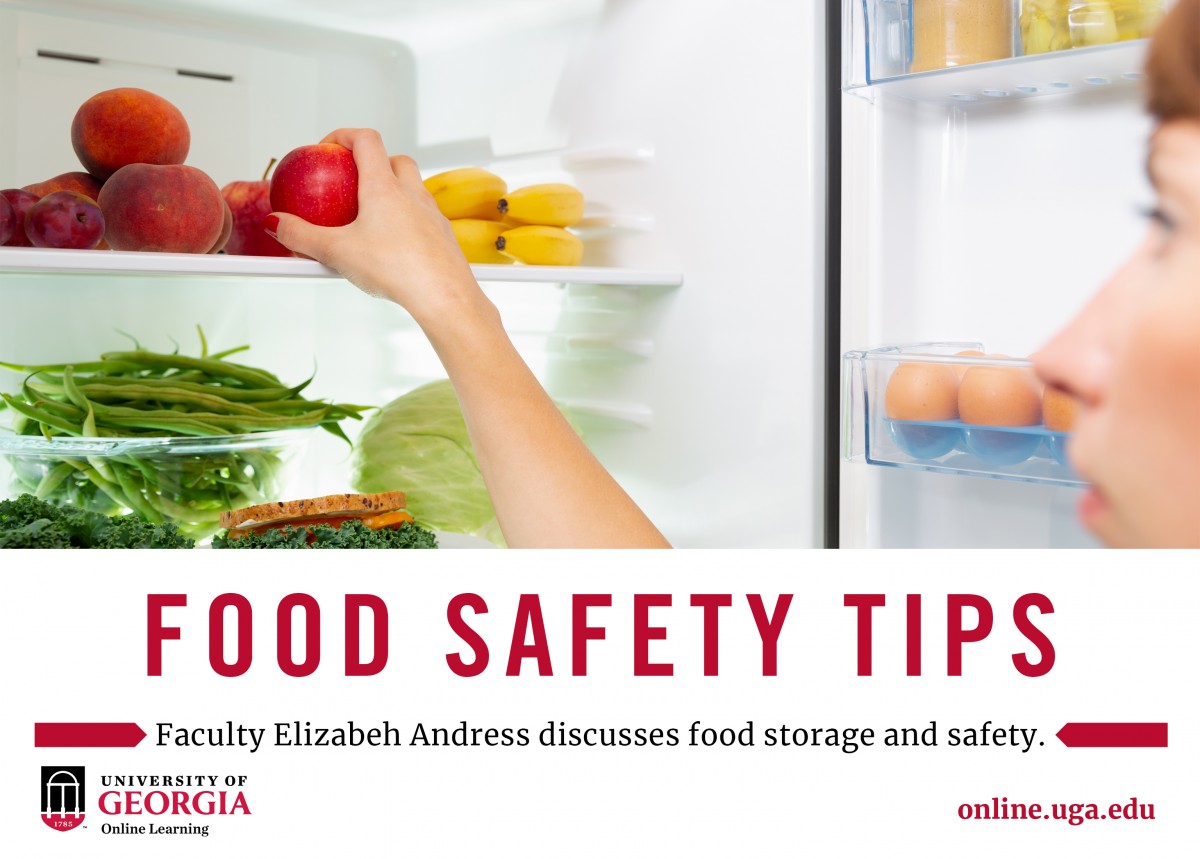Food Storage and Safety Tips
Food Storage and Safety Tips
If you are doing more cooking than usual due to coronavirus-related concerns, it’s important to make sure leftovers are stored properly.
One of the most important tasks is to ensure perishable foods – those that require cold storage to be held safely – are placed in the refrigerator or freezer within two hours of being cooked, according to UGA Extension food safety specialist and online M.S. Foods and Nutrition Professor for UGA Family & Consumer Sciences, Elizabeth Andress.
 “Cooking doesn’t remove all bacterial concerns from foods – they still have to be kept at recommended temperatures,” Andress said. “After food is safely cooked, enjoy your meal, but within two hours of cooking food or after it is removed from an appliance keeping it warm above 140 degrees Fahrenheit, leftovers must be refrigerated.”
“Cooking doesn’t remove all bacterial concerns from foods – they still have to be kept at recommended temperatures,” Andress said. “After food is safely cooked, enjoy your meal, but within two hours of cooking food or after it is removed from an appliance keeping it warm above 140 degrees Fahrenheit, leftovers must be refrigerated.”
For safe leftover preparation, make sure you have clean hands and work surfaces like cutting boards and counters, food storage containers and utensils are properly sanitized.
A clean apron also can help protect you as well as the food you work over.
“It would be best to start with a clean apron and dish towels or wipes and not those you used in meal preparation that may have come in contact with food residues at room temperature themselves,” Andress said.
Important tips for safe leftover preparation:
-
To prevent bacterial growth, it’s important that food cools rapidly to the safe refrigerator-storage temperature of 40 degrees or below. Divide large amounts of food into shallow containers. Cut or slice roasts, hams and whole turkeys into small pieces and fill into small containers. Other larger items like casserole dishes should be packaged in smaller portions.
-
Package your leftovers in tightly sealed containers or wraps for best quality. For freezer storage, packaging should be made of moisture and vapor-resistant materials to prevent freezer burn. Plastics should be “freezer-weight” (check labels on your bags or boxes) and glass jars should be meant for freezing as well with air-tight lids.
-
For freezing, be sure all sealing areas are clean and dry and that you leave recommended headspace for expansion. Moisture left on sealing surfaces can expand when it freezes and create air gaps in your seals. For details, visit the National Center for Home Food Preservation website at https://nchfp.uga.edu/how/freeze/headspace.html
-
Clearly label each package with the name of the food, ingredients and packaging date. Package foods in amounts you will be likely to use at one time.
-
Do not overload the refrigerator or freezer with warm leftovers, which could cause the temperature to rise above the recommended storage temperature. The small containers of your warm food can be spread out until cooled or frozen. A large stack of warm containers will cool more slowly.
-
The refrigerator temperature should keep foods at 40 degrees or below, so you might need the interior cabinet temperature to be around 38 degrees. The best freezer air temperature should be 0 degrees for best food quality and storage times.
-
When it’s time to enjoy the leftovers from the freezer, the safest way to thaw them is in the refrigerator. If foods are then to be reheated, reheat leftovers to at least 165 degrees and check the internal temperature of the thickest part with a food thermometer. Bring gravies, sauces and soups to a rolling boil as added safety.
“Avoiding foodborne illness is important, so don’t take shortcuts or waste time in getting to this task of storing leftovers quickly at the end of the meal,” Andress said.
You can see more about recommended food storage times and tips for safe preparation via the USDA’s FoodKeeper site, available online or as a mobile app: https://www.foodsafety.gov/keep-food-safe/foodkeeper-app
In other advice, Andress said takeout is a good choice to lower the risk of exposure because it reduces the number of touchpoints relative to eating in a restaurant.
“Current evidence shows the biggest risk of transmission of COVID-19 is being around individuals who are symptomatic,” Andress said. “Food businesses should be following employee health policies and local health department recommendations to keep these individuals home. At this time there also may be concern about people around us who are not yet symptomatic.”
Here, Andress answers some questions about coronavirus concerns related to food delivery and takeout.
Can you get coronavirus from food?
Information is still being learned about this virus and its transmission every day, but at this time the risk of being infected from food is thought to be low. Coronaviruses, like other viruses, need a living host to grow in, so they will not reproduce in food even though food can be contaminated with them. What we know now is the virus is spread mainly from person to person through respiratory droplets that can land in the mouth or noses of people who are nearby.
Should I be concerned about the risks associated with takeout, drive-through pickup or food delivered to my home?
Buying or receiving food is not something we can avoid, and the food chain does involve people and points of contact at various steps. The goal is to manage and minimize risks that are going to be present. If you are using the takeout or food delivery routes or even drive-through options at this time, you can choose those that offer no-touch/no interaction options to lower your risk.
The original article is here.
